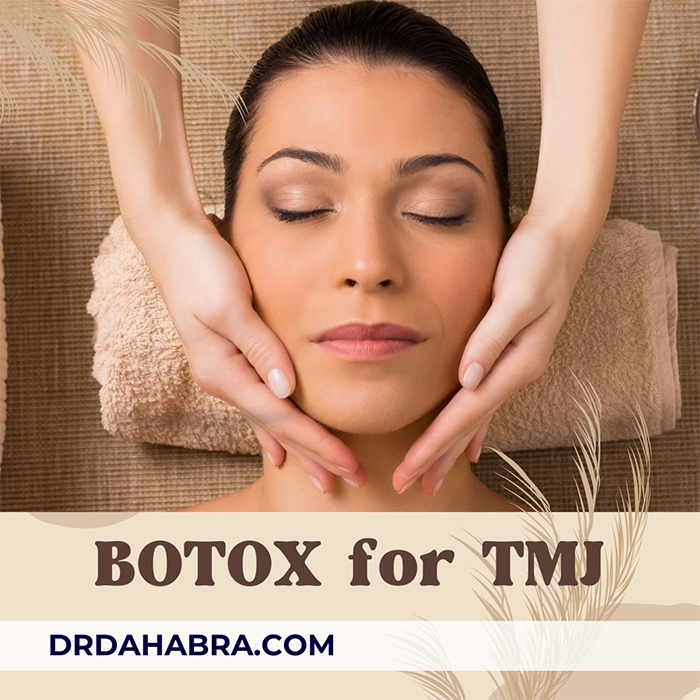Everything You Should Know About Botox for TMJ
Introduction: Understanding TMJ Disorders and Botox Treatment
Temporomandibular joint (TMJ) disorders affect millions of people, causing discomfort, pain, and difficulty in daily activities like speaking and chewing. This article is the complete guide to Botox for TMJ pain relief.
The TMJ connects your jawbone to the skull, acting as a hinge that allows smooth movement. However, when this joint becomes inflamed, overused, or misaligned, it can lead to TMJ disorders, often accompanied by symptoms like jaw pain, clicking sounds, and muscle stiffness.
Many individuals struggle with finding a practical solution, as TMJ treatments range from physical therapy to medications and even surgery.
One of the more recent and innovative approaches to TMJ disorder treatment is Botox injections. Botox, or botulinum toxin, is a neurotoxin that temporarily weakens the targeted muscles, preventing excessive contraction.
Botox helps reduce tension, decrease pain, and improve jaw mobility when injected into overactive jaw muscles. While Botox is widely known for its cosmetic applications, its medical benefits have been increasingly recognized in treating neuromuscular conditions, including TMJ disorders.
However, Botox for TMJ is not FDA-approved, meaning its use in this context is considered “off-label.” Despite this, many dentists, oral surgeons, and medical professionals offer Botox as an alternative for patients who haven’t responded well to conventional TMJ treatments.
With the rise of interest in this approach, many individuals search for information on “Botox for TMJ near me,” looking for experienced professionals to administer the treatment safely.
If you’re considering Botox for TMJ pain relief, this guide will provide you with everything you need to know.
Table of Contents
1. Mechanism of Botox in TMJ Therapy
2. Benefits of Botox for TMJ: Pain Relief
3. Benefits of Botox for TMJ: Reduction in Teeth Grinding (Bruxism)
4. Benefits of Botox for TMJ: Improved Jaw Function
5. Benefits of Botox for TMJ: Cosmetic Benefits
6. Diagnosis and Treatment Planning for TMJ Disorders
7. Considerations: Botox as a Symptomatic Treatment and Its FDA Approval Status
8. Potential Side Effects of Botox Injections
9. Botox as a Secondary Treatment Option for TMJ
10. Consulting a Professional: Importance of Expert Guidance
11. Duration of Botox Effects on TMJ Symptoms
12. Cost and Insurance Coverage for Botox Treatment
13. Post-Treatment Expectations: Recovery and Outcomes
14. Frequently Asked Questions (FAQs)
15. Conclusion
16. References
1. How Botox Works for TMJ Pain Relief
Botox works by blocking nerve signals that trigger muscle contractions. When injected into the masseter and temporalis muscles, Botox reduces excessive tension and overuse, which are common causes of TMJ pain.
This muscle relaxation alleviates pain and reduces jaw clenching and teeth grinding, which are commonly associated with TMJ disorders. Patients often notice improvements in jaw function and decreased associated symptoms within a few days to weeks after receiving Botox injections.
The process of getting Botox for TMJ is quick and minimally invasive. A trained professional identifies the most active muscles contributing to jaw tension and injects Botox at strategic points.
These Botox for TMJ injection sites typically include the masseter, temporalis, and sometimes the lateral pterygoid muscles. The procedure takes only 10–15 minutes, and there is little to no downtime, allowing patients to resume their daily activities immediately.
It’s important to understand that Botox is not a permanent solution. The effects usually last between three to six months, after which muscle activity gradually returns. Patients who experience relief often undergo repeat treatments to maintain the benefits.
However, individual responses vary, and while some find significant pain reduction, others may need additional therapies alongside Botox for optimal results.
2. Benefits of Botox for TMJ: Pain Relief
One of the primary reasons people consider Botox for TMJ is its effectiveness in reducing pain. TMJ disorders often cause chronic discomfort due to excessive muscle tension and inflammation.
By relaxing these overworked muscles, Botox helps alleviate persistent pain, making daily activities like chewing, talking, and yawning more comfortable. Many patients report significant improvement in their symptoms after just a few days.
Botox offers a more targeted and longer-lasting solution than traditional treatments like painkillers or muscle relaxants. While medications provide temporary relief, they do not directly address the root cause—muscle overactivity.
Botox, on the other hand, interrupts the pain cycle at its source, preventing excessive muscle contractions that contribute to TMJ pain.
Additionally, Botox provides a non-invasive alternative to surgery. For individuals who have tried various treatments without success, Botox serves as a middle ground before considering more drastic options.
Its ability to reduce pain without the need for invasive procedures makes it an attractive choice for many TMJ sufferers.
3. Benefits of Botox for TMJ: Reduction in Teeth Grinding (Bruxism)
Bruxism, or teeth grinding, is a common issue among people with TMJ disorders.
Many unconsciously grind their teeth, particularly at night, leading to jaw pain, headaches, and tooth damage. Botox can help reduce bruxism by weakening the masseter muscles decreasing the intensity of clenching and grinding.
Unlike night guards, which only protect teeth from damage, Botox targets the root cause of bruxism—excessive muscle activity. Patients often notice that after Botox injections, they no longer wake up with jaw soreness or tension headaches.
This relief can also improve sleep quality, as teeth grinding is often associated with disturbed sleep patterns.
In addition to pain relief, Botox can reduce bruxism and have long-term dental benefits. Chronic grinding wears down teeth, leading to increased sensitivity and the need for dental restorations like crowns or veneers.
By minimizing grinding, Botox helps preserve the natural structure of your teeth, preventing costly and invasive dental procedures in the future.
4. Benefits of Botox for TMJ: Improved Jaw Function
Limited jaw mobility and stiffness can be significant concerns for TMJ patients.
Some patients struggle with opening their mouths wide enough to eat or speak comfortably. Botox helps restore proper jaw function by reducing muscle tightness and allowing smoother movement.
Patients who undergo Botox treatment often experience a noticeable decrease in jaw locking, clicking, or popping. Since excessive muscle contractions contribute to these symptoms, relaxing the jaw muscles can improve overall function.
This makes daily tasks like chewing, speaking, and yawning effortless and pain-free.
Additionally, Botox may help those who experience jaw asymmetry due to muscle overuse. Some individuals develop an enlarged masseter muscle on one side due to uneven clenching.
Botox can balance muscle activity, leading to a more symmetrical jawline and improving function.
5. Benefits of Botox for TMJ: Cosmetic Benefits
Beyond pain relief and functional improvements, Botox for TMJ can also enhance facial aesthetics. Chronic jaw clenching and grinding can lead to muscle hypertrophy, where the masseter muscles enlarge, creating a more square-shaped jawline.
By relaxing and slightly shrinking the masseter muscles, Botox can lead to a softer, more contoured face shape. This effect particularly appeals to individuals whose jawline appears too prominent or masculine due to muscle enlargement.
Many people notice a more refined facial structure within a few weeks after treatment.
Furthermore, Botox can reduce the appearance of stress-related facial tension. TMJ disorders often cause tightness around the jaw and temples, making individuals look tense or strained.
By alleviating muscle tension, Botox improves comfort and helps create a more relaxed and youthful appearance.
6. Diagnosis and Treatment Planning for TMJ Disorders
Before undergoing Botox treatment for TMJ disorders, a proper diagnosis is essential.
TMJ issues can arise from various causes, including arthritis, jaw misalignment, teeth grinding (bruxism), and stress-induced muscle tension. Since symptoms like jaw pain, headaches, and clicking noises overlap with other conditions, a healthcare professional must evaluate your situation to determine if Botox is the right solution.
A TMJ diagnosis typically involves a physical examination, patient history, and sometimes imaging tests such as X-rays, CT scans, or MRIs. The doctor or dentist will assess jaw movement, muscle tenderness, and joint function.
Additionally, they may perform the three-finger test for TMJ, where patients attempt to place three fingers vertically in their mouth. If they struggle to do so, it can indicate restricted jaw mobility, a common sign of TMJ disorders.
Once diagnosed, a customized treatment plan is developed. While Botox can be a practical option, professionals often recommend trying conservative approaches first, such as physical therapy, mouthguards, or lifestyle modifications.
Botox may be introduced as part of a broader strategy to manage symptoms if these treatments fail.
7. Considerations: Botox is Not a Cure & FDA Approval Status
One of the key points to understand about Botox for TMJ is that it is a symptomatic treatment, not a cure.
TMJ disorders can have structural, inflammatory, or behavioral causes, and Botox only addresses muscle-related symptoms. While it provides significant relief for many patients, it does not fix underlying jaw misalignment, joint damage, or chronic stress patterns.
Additionally, Botox is not FDA-approved for TMJ treatment. Although widely used in medical and cosmetic applications, Botox is administered for TMJ on an off-label basis, meaning its safety and effectiveness for this condition have not been officially endorsed by the FDA.
Despite this, many oral surgeons and neurologists recognize its benefits and offer it a viable treatment for TMJ-related discomfort.
Patients should consult with a licensed healthcare professional before proceeding with Botox.
Understanding the risks, benefits, and alternatives is crucial, as Botox is best suited for individuals who have not responded to conventional treatments or experience severe muscle tension contributing to their TMJ symptoms.
8. Potential Side Effects of Botox Injections
Like any medical treatment, Botox for TMJ comes with potential side effects.
While the procedure is generally safe, some patients may experience mild to moderate reactions at the injection sites. These include swelling, redness, bruising, or tenderness, which usually subside within a few days.
Less common side effects involve temporary muscle weakness, difficulty chewing, or unintended facial asymmetry. Because Botox relaxes the muscles, some patients may find it harder to bite into tough foods or notice a slight imbalance in their jaw movement.
This effect usually resolves as the Botox gradually wears off.
Rarely, headaches, flu-like symptoms, or temporary eyelid drooping can occur. These side effects are uncommon and typically result from the spread of Botox to unintended areas.
Choosing a skilled professional with experience in Botox for TMJ injection sites can minimize these risks.
9. Botox is Not a First-Line Treatment for TMJ
While Botox is an effective option, it is not considered the first line of treatment for TMJ disorders. Healthcare professionals typically recommend less invasive approaches before resorting to Botox injections.
First-line treatments include jaw exercises, stress management techniques, oral splints (mouthguards), and anti-inflammatory medications. Many TMJ issues stem from muscle overuse or jaw misalignment, which can often be managed with physical therapy and lifestyle changes.
Botox is usually introduced only when these methods fail to provide adequate relief.
Moreover, TMJ symptoms can sometimes improve naturally or with simple interventions like avoiding hard foods, correcting posture, and using heat/cold therapy. Patients should discuss all available options with their provider before considering Botox as part of their treatment plan.
10. Always Consult a Professional
Because Botox for TMJ is an off-label treatment, finding an experienced and qualified practitioner is essential. Not all Botox providers specialize in TMJ treatment, so looking for professionals with expertise in oral and maxillofacial conditions is crucial.
Patients often search for “Botox for TMJ near me” to find local providers, but they should verify credentials before scheduling an appointment. A good provider will conduct a thorough assessment, discuss potential risks and benefits, and customize the injection sites based on individual needs.
Additionally, discussing treatment expectations with a professional helps ensure a realistic understanding of Botox’s effects. A qualified specialist can determine how many units of Botox are needed for TMJ, which varies based on severity and muscle strength.
11. How Long Does Botox Last for TMJ?
Botox does not provide a permanent solution for TMJ pain. Most patients experience relief within 5 to 7 days, with maximum effects appearing around two weeks after injection.
The effects of Botox typically last between 3 to 6 months, depending on individual metabolism and lifestyle factors. For some patients, relief extends up to 8 months, while others may require a repeat session sooner.
Regular follow-ups help maintain consistent symptom relief.
As Botox wears off, jaw muscle activity gradually returns, which may cause symptoms to reappear. Some patients find that repeated Botox sessions decrease muscle tension over time, requiring fewer injections in the long run.
12. Cost and Insurance: What to Expect
The cost of Botox for TMJ varies widely based on location, provider experience, and the number of units required.
Botox treatment for TMJ can range from $300 to $1,500 per session. The total expense depends on the severity of the condition and how many Botox units are injected into the masseter and temporalis muscles.
Many patients wonder, “Will insurance cover Botox for TMJ?” Unfortunately, because Botox is not FDA-approved for TMJ disorders, most insurance companies do not cover the treatment.
However, some providers offer payment plans or financing options to make it more affordable.
Patients should consult their insurance provider to determine if coverage is available. Sometimes, partial reimbursement may be possible if a physician deems Botox medically necessary.
13. Post-Treatment: What to Expect After Botox for TMJ
After receiving Botox for TMJ, patients should follow post-treatment care guidelines to maximize results. While there is minimal downtime, it’s recommended to avoid rubbing the injection sites, lying down for at least four hours, or engaging in strenuous activities for 24 hours.
Some patients experience mild soreness, bruising, or tightness in the jaw within the first few days. These symptoms typically subside within a week. Applying cold compresses and avoiding excessive jaw movements can help reduce discomfort.
Patients may also notice subtle jaw function or facial shape changes within a few weeks. Since Botox relaxes the masseter muscles, some individuals experience a slimmer jawline.
However, follow-up appointments can fine-tune the treatment for those requiring additional adjustments.
14. Frequently Asked Questions (FAQs) About The Complete Guide to Botox for TMJ Pain Relief
Q1. Can Botox relieve TMJ pain?
Concise Answer: Yes, Botox can relieve TMJ pain by relaxing the jaw muscles, reducing tension, and alleviating associated symptoms like headaches and teeth grinding.
Detailed Answer: Botox temporarily weakens the overactive jaw muscles responsible for TMJ pain. When injected into the masseter and temporalis muscles, it reduces excessive contractions, which helps relieve jaw tension, discomfort, and inflammation.
Many patients experience significant pain relief within a few days to weeks after the procedure. However, since Botox does not treat the underlying cause of TMJ disorders, it is often recommended as part of a broader treatment plan that may include physical therapy, mouthguards, or stress management techniques.
Q2. What is the three-finger test for TMJ?
Concise Answer: The three-finger test is a simple way to check jaw mobility—if you cannot fit three fingers vertically into your mouth, it may indicate TMJ dysfunction.
Detailed Answer: Healthcare professionals use the three-finger test to assess jaw movement and flexibility. Usually, a person should be able to place three fingers (index, middle, and ring) between their upper and lower front teeth without discomfort.
It may signal restricted jaw movement, often associated with TMJ disorders if this is difficult or painful. A limited opening could indicate muscle tightness, joint inflammation, or structural issues within the temporomandibular joint.
If you experience persistent jaw stiffness or pain, a consultation with a healthcare provider is recommended.
Q3. Will insurance cover Botox for TMJ?
Concise Answer: Most insurance plans do not cover Botox for TMJ since it is not FDA-approved for this condition, but exceptions may exist if deemed medically necessary.
Detailed Answer: Because Botox is considered an “off-label” treatment for TMJ disorders, many insurance providers classify it as a cosmetic or elective procedure, meaning it is typically not covered. However, some insurance plans may offer partial reimbursement if a doctor provides medical justification, such as severe pain or muscle dysfunction that has not responded to other treatments.
Patients are advised to contact their insurance provider directly to determine if coverage is possible and if any documentation is required.
Q4. What are the downsides of jaw Botox?
Concise Answer: Potential downsides include temporary muscle weakness, difficulty chewing, facial asymmetry, bruising, and the need for repeat treatments.
Detailed Answer: While Botox is generally safe, some patients may experience unwanted effects such as mild pain, swelling, or headaches after the injections. Since Botox reduces muscle strength, some individuals initially find it harder to chew tough foods.
Occasionally, improper injection placement can lead to facial asymmetry or unintended muscle relaxation. Additionally, Botox is not a permanent solution—it typically lasts 3–6 months, requiring ongoing treatments for sustained relief. Choosing a skilled provider can help minimize these risks.
Q5. How much Botox is needed for severe TMJ?
Concise Answer: The amount of Botox needed for severe TMJ varies, but most patients require between 20 to 50 units per side, depending on muscle strength and symptoms.
Detailed Answer: The number of Botox units needed for TMJ treatment depends on the severity of muscle tension and individual anatomy. On average, providers administer between 20 to 50 units per side, targeting the masseter and temporalis muscles.
In cases of severe TMJ pain or bruxism, a higher dose may be required. A consultation with a provider will help determine the exact dosage based on muscle assessment and symptom severity.
Q6. What is the success rate of Botox for TMJ?
Concise Answer: Studies suggest that Botox has a success rate of 70–90% in reducing TMJ-related pain and improving jaw function.
Detailed Answer: While results vary, many patients report significant relief from TMJ symptoms after Botox treatment. Clinical studies indicate that 70–90% of individuals experience a noticeable improvement in pain levels, jaw function, and teeth grinding reduction.
The effectiveness of Botox largely depends on proper injection technique, the severity of the TMJ disorder, and the individual’s response to treatment. Regular follow-up injections may be needed for continued benefits.
Q7. How long does Botox last for TMJ?
Concise Answer: Botox for TMJ typically lasts 3 to 6 months, after which muscle function gradually returns.
Detailed Answer: Most patients experience relief within a few days to two weeks after Botox injections, with effects lasting about 3 to 6 months. Over time, as the Botox wears off, muscle activity gradually returns, and symptoms may reappear.
Regular treatments can help maintain long-term relief, and some patients find that repeated Botox sessions lead to longer-lasting results as their jaw muscles adapt to reduced tension.
Q8. What are the side effects of Botox for TMJ?
Concise Answer: Common side effects include mild swelling, bruising, temporary muscle weakness, and headaches.
Detailed Answer: Most side effects of Botox for TMJ are mild and temporary. Common reactions include swelling, bruising, tenderness at the injection site, and mild headaches.
Some patients experience temporary difficulty chewing, a slight change in facial expression, or minor asymmetry. Serious side effects are rare but can occur if Botox spreads to unintended areas.
Choosing an experienced injector can minimize risks and ensure optimal results.
Q9. How to get rid of TMJ Botox effects?
Concise Answer: Botox naturally wears off in 3–6 months if unwanted effects occur, but facial massage and physical therapy may help speed up the process.
Detailed Answer: Botox effects cannot be reversed immediately but will gradually wear off over several months. Facial massage, physical therapy, and increased muscle activity can help break down Botox more quickly in cases of unwanted side effects.
Some doctors may also use heat therapy or prescribe medications to enhance nerve signaling and restore muscle function faster.
Q10. Where to inject Botox for TMJ?
Concise Answer: Depending on symptoms, Botox is injected into the masseter and temporalis muscles, and sometimes the lateral pterygoid muscle.
Detailed Answer: Botox is typically injected into the masseter (jaw muscle) and temporalis (side of the head) muscles for TMJ treatment to relieve tension and pain. In some cases, additional injections may be placed in the lateral pterygoid muscle if excessive jaw movement contributes to the disorder.
A skilled provider will assess the best locations based on individual symptoms.
Q11. How many units of Botox are needed for TMJ?
Concise Answer: Most patients need 20–50 units per side, depending on jaw muscle size and severity of symptoms.
Detailed Answer: The number of units required varies per patient. On average, 20–50 units per side are injected into the masseter and temporalis muscles. Individuals with severe bruxism or stronger jaw muscles may need higher doses.
A provider will determine the appropriate amount based on muscle assessment and symptom severity.
Q12. Does Botox for TMJ change face shape?
Concise Answer: Botox can slim the jawline by reducing the size of the masseter muscles over time.
Detailed Answer: One of the side effects—or benefits—of Botox for TMJ is its ability to change face shape. Since the masseter muscles contribute to a wide or square jawline, repeated Botox injections cause these muscles to shrink (atrophy) over time.
As a result, the face may appear slimmer, especially in individuals with naturally strong or hypertrophic masseter muscles. The extent of change depends on the number of units injected and the individual’s muscle structure.
Some patients seek Botox for TMJ primarily for its cosmetic jaw-slimming effect.
Q13. Does Botox for TMJ work?
Concise Answer: Yes, Botox is effective in reducing TMJ-related muscle pain, jaw tension, and bruxism in most patients.
Detailed Answer: Multiple studies and patient experiences suggest that Botox significantly relieves TMJ pain, teeth grinding, and muscle tension. By relaxing the overactive jaw muscles, Botox can improve mobility and decrease symptoms like headaches and jaw clicking.
While results vary, many patients report a noticeable reduction in discomfort within a few weeks of treatment. However, since Botox is not a cure, continued treatments may be necessary for long-term management.
Q14. Who is a good candidate for TMJ Botox?
Concise Answer: People with persistent TMJ pain, jaw clenching, or teeth grinding who haven’t found relief with other treatments may be good candidates.
Detailed Answer: Botox for TMJ is ideal for individuals who experience chronic jaw pain, muscle tightness, or bruxism that hasn’t improved with traditional treatments such as night guards, physical therapy, or medication. Suitable candidates should have realistic expectations and be willing to undergo repeat treatments as needed.
However, those with underlying joint damage, severe arthritis, or structural issues in the jaw may need alternative treatments. Consulting a specialist can help determine whether Botox is the right option.
Q15. Who shouldn’t get masseter Botox?
Concise Answer: People who are pregnant, breastfeeding, have neuromuscular disorders, or have a history of allergic reactions to Botox should avoid it.
Detailed Answer: Masseter Botox is not suitable for everyone. Individuals who are pregnant or breastfeeding should avoid Botox, as its effects on fetal development and breast milk are not well-studied.
Additionally, those with neuromuscular disorders (such as myasthenia gravis or ALS) may be at a higher risk of complications. Anyone with a history of allergic reactions to Botox or botulinum toxin injections should also avoid treatment.
Patients should discuss their medical history with a qualified provider to determine whether Botox is safe for them.
15. Conclusion: The Complete Guide to Botox for TMJ Pain Relief
Living with TMJ disorders can be exhausting—waking up with jaw pain, struggling to chew without discomfort, and enduring the constant tension that radiates to your head and neck.
If you’ve tried everything—mouthguards, pain relievers, physical therapy—and still feel trapped in a cycle of discomfort, Botox might be the solution you’ve been searching for. By relaxing the overactive jaw muscles, Botox for TMJ offers more than just pain relief—it can restore your comfort, improve your daily function, and even enhance your facial appearance.
However, Botox is not a magic cure. It won’t fix joint misalignment or permanently stop bruxism, and it’s not FDA-approved specifically for TMJ treatment.
But for many patients, it provides a lifeline—an escape from relentless pain and jaw tension that no other treatment has relieved. The success stories are real: people who once suffered from chronic headaches and aching jaws now wake up feeling refreshed, free from the clenching and grinding that once ruled their nights.
If you’ve exhausted traditional treatments and still feel no relief, why not explore Botox as an option?
Ultimately, your well-being is what matters most.
Whether you decide on Botox or another treatment path, seeking professional guidance is the first step toward reclaiming your comfort and quality of life. TMJ pain doesn’t have to define your days.
Relief is possible, and you deserve to experience it.
If you’re ready to take the next step, consult a trusted professional and start your journey toward a pain-free, tension-free life today.
We have covered everything about the complete guide to Botox for TMJ pain relief.
Relieve TMJ Pain with Expert Botox Treatment Today!
Say goodbye to jaw pain, tension headaches, and teeth grinding with professional Botox for TMJ treatment. Experience the relief you deserve and restore your comfort with a trusted specialist.
Why wait to reclaim your quality of life?
Call us now at (954) 595-2607 or book online. Your journey begins with just a click or a call.
Embrace the beauty, embrace innovation – Embrace You.
16. References
- Dr. Chadi Dahabra
- Plantation Med Spa
- West Palm Beach Med Spa
- Botulinum toxin in the treatment of myofascial pain syndrome of masticatory muscles
- Management of temporomandibular joint disorders with botulinum toxin: A systematic review
- Effect of botulinum toxin on masticatory muscle pain in patients with temporomandibular disorders: a randomized, double-blind, placebo-controlled pilot study
- Efficacy of botulinum toxin type A for treatment of persistent myofascial TMD pain: a randomized, controlled, double-blind multicenter study
- Botulinum toxin type A and acupuncture for masticatory myofascial pain: a randomized clinical trial
- Long-term effects of a single application of botulinum toxin type A in temporomandibular myofascial pain patients: A controlled clinical trial
- Effects of botulinum toxin type A on the psychosocial features of myofascial pain TMD subjects: A randomized controlled trial
- The effect of laser and botulinum toxin in the treatment of myofascial pain and mouth opening: A randomized clinical trial
- The effectiveness of botulinum toxin for temporomandibular disorders: A systematic review and meta-analysis




